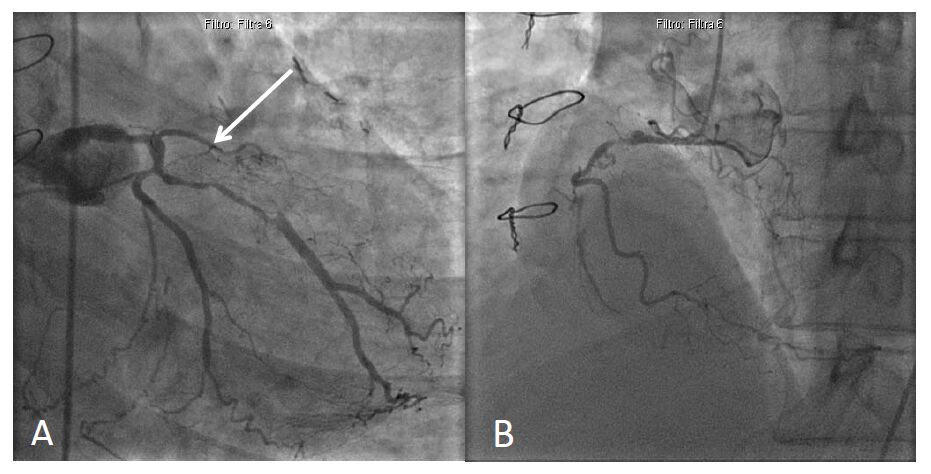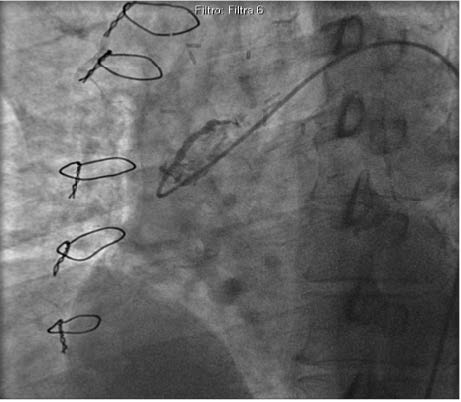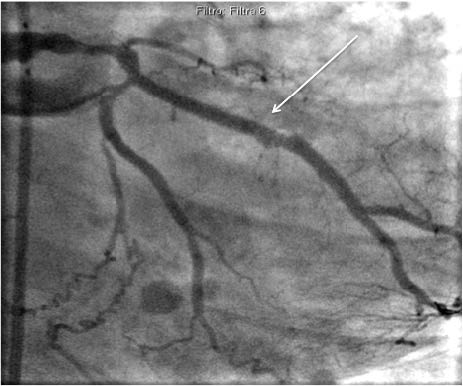1. Introduction
Despite recent advances in techniques and equipment for percutaneous coronary intervention (PCI), saphenous vein graft (SVG) disease still constitutes a major challenge for interventional cardiologists. Indeed, since patients with SVG disease have often a high-risk profile because are older and have severe comorbidities, they do not represent the "ideal patient" for cardiac surgeons to perform a redo coronary artery by-pass graft (CABG) surgery. On the other hand, since lesions of SVG often are friable and prone to thrombosis as well as to thrombotic distal embolization, these vessels represent a real challenge for interventional cardiologists [1,2].
In CABG patients with stable angina, therapeutic options include medical therapy or, if technically feasible, PCI of native vessels because of better short- and long-term results rather than PCI of SVG [3,4]. Conversely, in patients with acute myocardial infarction due to acutely occluded SVG, although not specifically addressed in the guidelines, PCI of the occluded vessel should be performed. However, although acute revascularization of an infarct-related SVG is possible in the majority of cases and a high patency rate was observed at angiographic follow-up, the clinical prognosis of these patients has been demonstrated to be quite poor [5]. In this report, we describe a case of a patient with acute thrombosis of SVG in whom we decided to perform PCI of the native artery supplying the same myocardial territory of the acutely occluded SVG as alternative approach to minimize the risk of recurrent adverse events.
2. Case Description
A 75-year-old man, with history of hypertension and dyslipidemia was admitted to our emergency room with chest pain, nausea, hypotension and diaphoresis started since about 90 minutes. Moreover, the patient had a clinical history of coronary artery disease treated by coronary artery by-pass (CABG) 18 years earlier and, 16 years after CABG, since he had stable angina, by PCI with implantation of two overlapping drug eluting stents (DES) to treat significant stenosis of the proximal segment of SVG to first obtuse marginal (OM) branch. The patient, according to the guidelines, had interrupted double antiplatelet therapy one year after stent implantation and was under acetylsalicilic acid (100 mg/die). At the admission, EKG showed elevation of the ST segment in the in lateral leads suggesting a diagnosis of ST elevated myocardial infarction (STEMI). Ultra-sensitivity cardiac troponin T assay revealed a significant positivity and fast-track echocardiographic observation displayed ipo-akinesia of the postero-lateral wall. The patient received 500 mg of acetylsalicylic acid intravenously and 180 mg of ticagrelor per os and was addressed to the cath-lab to perform coronary angiography and primary PCI. Coronary angiography revealed severe disease of native coronary arteries: left anterior descending (LAD) was occluded at the origin, the first Obtuse Marginal (OM) had a severe, long lesion in its proximal segment and right coronary artery (RCA) was distally occluded (Figure 1,panel A and B). Angiography of the left internal mammary artery (LIMA) to LAD showed patency of LIMA and of native vessel. On the contrary, SVG previously treated with DES implantation was occluded with evidence of massive thrombosis. (Figure 2). As reported above, native OM appeared distally patent with a severe stenosis before SVG anastomosis, responsible of severe slow flow in the distal part of this vessel. Thus considering the thrombotic burden of the occluded vessel and the high risk of distal embolization in this acute clinical setting, we decided to approach the native MO to obtain vessel revascularization rather than try to re-open the SVG. After administrating unfractionated heparin (UFH) a Whisper Extra-Support guide wire (Abbott Vascular) was carefully advanced through the long lesion that was then pre-dilated and finally treated by deploying three everolimus-eluting stents in overlap (Figure 3). The patient was discharged six days after hospitalization under optimized medical therapy, and at 12-months, no adverse events occurred and the patient was free of symptoms.
3. Discussion
Percutaneous coronary interventions (PCI) to treat atherosclerotic disease of SVG currently account for approximately 6% of all PCI and for 3% of all PCI-treated acute myocardial infarction [2]. However, since these acute patients are still underrepresented in large clinical trials [6], their optimal management remains still uncertain. Brilakis et al. reported short and long-term outcomes of 34 consecutive patients treated by PCI for acutely occluded SVG. These patients were successfully treated with a procedural success rate of 81%. However, incidence of recurrent events was very high because the incidence of 1-and 3-year mortality was 8% and 42%, respectively. Moreover, 38% of these patients needed coronary revascularization at 3 years [7]. In line with these not encouraging results, in another report it has been demonstrated that, in patients with acute myocardial infarction due to a culprit lesion of SVG treated by PCI, despite lower levels of peak troponin than patients with a culprit lesion of native coronary vessel, the incidence of death and adverse events was significantly higher [8]. A possible explanation for these disappointing results might be that SVG has specific peculiar features. In fact, SVG lesions are often very friable and have a very thin fibrous cap. More important, since SVG are large diameter vessels that have anastomosis on smaller, native coronary arteries, they have a slow blood flow that might lead to a very high thrombotic burden. These SVG peculiarities might cause distal embolization of atherothrombotic debris that, in turn, leads to severe impairment of the vessel final flow. Nevertheless, the utility of embolic protection device has not been specifically studied in acute MI due to culprit lesions of SVG.
Another important issue to consider is represented by conflicting data about stenting of SVG. In the largest trial that was powered for a clinical endpoint, Mehilli et al. have demonstrated that patients treated with first generation drug-eluting stents (DES) had significantly lower incidence of target lesion revascularization (TLR) compared with bare-metal stents (BMS) with a similar rate of death, myocardial infarction and stent thrombosis [9]. Moreover, Brilakis et al, in the SOS (Stenting of Saphenous Vein Grafts) trial demonstrated that, during long-term follow-up, use of PES was associated with significantly better clinical outcomes than BMS in SVG lesions [3]. However, results from long-term follow-up obtained by other studies in which the performance of DES in SVG disease has been evaluated, seem not to be in line with those obtained in this promising study. Indeed, in the randomized Extended Duration of the Reduction of Restenosis In Saphenous vein grafts with Cypher stent (DELAYED RRICS), the authors sought to provide long-term follow-up data of sirolimus-eluting stents (SES) versus bare-metal stents (BMS) in saphenous vein grafts (SVG). In this secondary post-hoc analysis, BMS were associated with lower long-term mortality than SES for SVG disease. Also, the 6-month reduction in repeated revascularization procedures with SES was lost at longer-term follow-up [10].
The role of newer generation DES to treat SVG is still controversial. Since data regarding the use of second-generation DES in SVG were lacking, several research groups have investigated the clinical outcomes between first- and second-generation DES in SVGs. Specifically, Costopoulos et al. have demonstrated that second-generation DES are at least comparable with first-generation DES with regard to clinical outcomes at midterm follow-up [11]. Similarly, Taniwaki et al have recently shown that, among patients undergoing PCI for SVG lesions, newer-generation everolimus-eluting stent (EES) have similar safety and efficacy to early-generation SES and PES during long-term follow-up to four years [12]. Promising results were those of Kitabata et al. because they concluded that the superiority of second-generation EESs compared with first-generation DESs shown in native artery lesions, may been extended to saphenous vein graft lesions. Moreover, they suggested that these stents should be considered as the DES of choice for this lesion type [13].
Finally, another crucial issue in treating SVG lesions seems represented by the presence of thrombus in the vessel. In fact, it has been demonstrated that percutaneous treatment of SVGs with elevated thrombotic burden is associated with a very low success rate. Specifically, in this population of ACS patients, stenting of SVG was associated to high incidence of stent thrombosis and to increased incidence of recurrent events [7].
4. Conclusions
In the present clinical case, we have kept in mind all the concerns reported above about PCI in SVG and, specially, in acute occluded SVG with high thrombus burden, and have decided to go through the native road instead to reopen the culprit SVG. Although the main temptation might be to approach the acutely occluded vessel, if feasible, PCI of native coronary artery could be considered as the optimal treatment in this clinical setting.
Conflict of Interest
None of the authors has conflict of interests.










 DownLoad:
DownLoad: 






